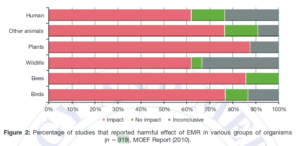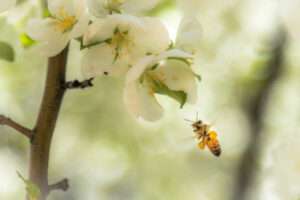 1G & UP Wireless Harms Butterflies, Birds, Bees . . .
1G & UP Wireless Harms Butterflies, Birds, Bees . . .
Last updated 4 October 2023
Insects have declined by 75% in the last three decades (1). For butterflies like monarchs, the risks of wireless broadband radiation are on top of risks from toxic spraying and habitat loss. Besides research showing higher wireless frequencies raise the body temperature of insects (2), Dr. Kostoff has theorized that higher frequency 5G technology may destroy the sensing mechanisms of insects, such as the antenna of butterflies, which also equals death (3). Later studies have found 5G frequencies above 3 GHz may lead to an 390-570% rise of honeybee frequency absorption (4), with effects expected on behavior, morphology, and physiology. Honeybee studies have also shown wireless causes hive desertion (5), stress (6), and threateningly curtails honey and egg production (7). In 2021, a multi-stress study examined the combined effects of pesticides and non-ionizing radiation and found only 1 hive remaining of 4 at the end of the season (8).
We have not yet seen the impact of honeybee declines because beekeepers are increasing populations by establishing queen colonies that normally would not exist. Still, a 2017-2018 survey shows losses – a decline of 51% for backyard beekeepers as compared to 21% from 2007 to 2008 (9).
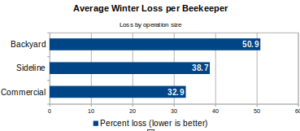
Hive desertion by honeybees may not only be a function of severe discomfort, but of disorientation. A 2014 study provides evidence that wireless disrupts the internal compass of European robins (10); a 2016 study has found orientation of European robins disrupted by weak broadband (wireless) signals (11).

Butterflies similarly orient with a magnetic compass sensitive to ultraviolet A and blue light (12). Senior study author of butterfly magnetic compass research Steven Reppert , a distinguished professor of neurobiology at UMass Medical School, notes butterflies are likely vulnerable to “electromagnetic noise,” a term which includes wireless and light (13). Studies on bees and butterflies have shown orientation disrupted by magnetic fields, although the frequencies and power levels were not necessarily wireless communications (14, 15, 16).
The type of frequency used can change the impact or focus of the frequency, and so research is needed on different frequencies upon different forms of life, from plants to fungi to cells. Commonalities may exist because, just as in human beings, application of a magnetic field in bees also can generate calcium efflux or other biological effects (17, 18).
The United States Environmental Protection Agency (EPA) has shared concerns over wireless and power frequency exposures for over two decades, submitting for example docket reports on threats to wildlife from cell towers. In 1990, the EPA prepared a report, never to be officially released, recommending radio-frequencies, including wireless communications, be considered a “possible human carcinogen” and power frequencies classified as “probable human carcinogens.” Legal power limits for these frequencies are currently set by the Federal Communications Commission (FCC), and the EPA has consistently objected to the FCC’s cavalier stance and emphasized that the guidelines neglect “chronic, nonthermal exposure.”
In 1990, the EPA prepared a report, never to be officially released, recommending radio-frequencies, including wireless communications, be considered a “possible human carcinogen” and power frequencies classified as “probable human carcinogens.” Legal power limits for these frequencies are currently set by the Federal Communications Commission (FCC), and the EPA has consistently objected to the FCC’s cavalier stance and emphasized that the guidelines neglect “chronic, nonthermal exposure.”
Not only flying species use or depend on a magnetic compass. Even ants utilize a magnetic compass to find home (19). Surprisingly, foxes use a magnetic compass to hunt prey hidden by snow (20).
T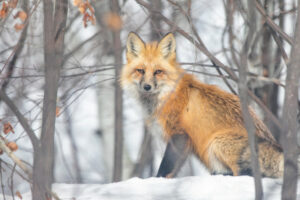 he scale of our losses from implementation of wireless has not been officially monitored by US government, but is being reported by concerned scientists. Botanist Mark Broomhall has submitted to UNESCO and IUCN a report documenting a correlation between new wireless generations and 70–90% losses in insects and birds, besides the disappearance of several species on Mt. Nardi, in the world heritage site and Australian National Nightcap Park (19). Across the world ongoing familiar reports of losses in insect population, tree fertility, bat susceptibility to infection, etc., align with the development of new wireless generations as well scientific evidence and understanding.
he scale of our losses from implementation of wireless has not been officially monitored by US government, but is being reported by concerned scientists. Botanist Mark Broomhall has submitted to UNESCO and IUCN a report documenting a correlation between new wireless generations and 70–90% losses in insects and birds, besides the disappearance of several species on Mt. Nardi, in the world heritage site and Australian National Nightcap Park (19). Across the world ongoing familiar reports of losses in insect population, tree fertility, bat susceptibility to infection, etc., align with the development of new wireless generations as well scientific evidence and understanding.
While the above provides a sampling, more recently, journalist Blake Levitt and scientists Henry Lai and Albert Manville submitted peer-reviewed journal articles that provide details on copious studies showing harm to both flora and fauna (22-25).
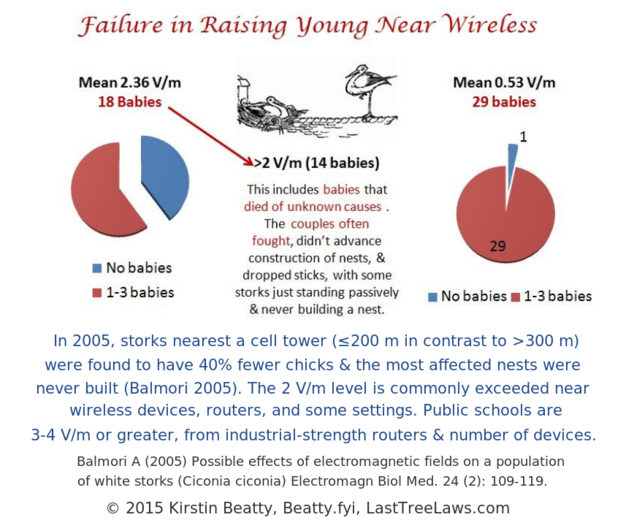
5G Heats Bugs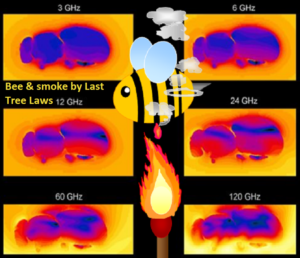
Initial research conducted by Thielens et al (2018) found higher frequencies caused heating of small insects. One thermal imaging picture from the research shows heating of a bee (pictured). This kind of heating can damage the bee locally, condemning the bee to death.
Later research by Thielens et al (2020) also found that at 3 GHz honeybee temperatures began to rise. Looking at the frequencies being used for wireless, keep in mind that 2.5 GHz or lower frequencies have been fairly common, with 3.5 GHz use rising in 2019 to meet growing demand. For 5G on land, carriers are using or introducing the 28, 38, and 60 GHz band. For 5G access via space, the FCC has approved 37.5 to 42 GHz and 47.2 to 51.4 GHz. The FCC is also now allowing experimentation above 95 GHz, and has approved thousands of satellites, insuring wireless on Earth.
One other reason 5G wireless development is worrying honest experts is because some of the wireless frequencies have resonance not only with bees, but water, oxygen, and other life. What’s resonance?
Resonance means that like pushing a swing at the right time, the frequency’s wave has greater swing or power which thus increases risk of heating and breakage as it locks on, whether onto molecules or other parts of life.
Body resonance led to heating of the bee pictured. Resonance of oxygen could interfere with our breathing. Even without 5G, our current exposures are causing serious harm, from infertility to learning disabilities. All this points to a need to support independent science, media, and the Precautionary Principle.
More information on the phenomenon of resonance can be found by searching duckduckgo dot com. The Environmental Health Trust has compiled historical documents showing concern by the EPA.
References:
-
-
-
-
-
- Hallmann et al. (2017) Hallmann CA, Sorg M, Jongejans E, Siepel H, Hofland N, Schwan H, Stenmans W, Müller A, Sumser H, Hörren T, Goulson D. More than 75 percent decline over 27 years in total flying insect biomass in protected areas. PLOS ONE. 2017;12:e0185809 doi: 10.1371/journal.pone.0185809.
- Arno Thielens, Duncan Bell, David B. Mortimore, Mark K. Greco, Luc Martens & Wout Joseph, Exposure of Insects to Radio-Frequency Electromagnetic Fields from 2 to 120 GHz, Scientific Reports volume 8, Article number: 3924 (2018)
- Email thread theory from Dr. Ronald Kostoff (see below). Career description: Ph. D. in Aerospace and Mechanical Sciences from Princeton University in 1967; subsequently worked for Bell Laboratories, Department of Energy, Office of Naval Research, and MITRE Corp; published over 200 peer-reviewed articles; served as Guest Editor of four journal Special Issues since 1994; obtained two text mining system patents; presently am a Research Affiliate at Georgia Institute of Technology.
- Thielens, A., Greco, M. K., Verloock, L., Martens, L., & Joseph, W. (2020). Radio-Frequency Electromagnetic Field Exposure of Western Honey Bees. Scientific reports, 10(1), 461. https://doi.org/10.1038/s41598-019-56948-0
- Sainudeen, Sahib.S. “Electromagnetic Radiation (EMR) Clashes with Honey Bees.” International Journal of Environmental Sciences, vol. 1, no. 5, 2011.
- Favre, Daniel. “Mobile phone induced honeybee worker piping.” Apidologie, vol. 42, 2011, pp. 270-9.
- Sharma, V.P. and N.K. Kumar. “Changes in honeybee behaviour and biology under the influence of cellphone radiations.” Current Science, vol. 98, no. 10, 2010, pp. 1376-8.
- Lupi D, Palamara Mesiano M, Adani A, Benocci R, Giacchini R, Parenti P, Zambon G, Lavazza A, Boniotti MB, Bassi S, Colombo M, Tremolada P. Combined Effects of Pesticides and Electromagnetic-Fields on Honeybees: Multi-Stress Exposure. Insects. 2021 Aug 10;12(8):716. doi: 10.3390/insects12080716. PMID: 34442282; PMCID: PMC8396937.
- Report: Loss by operation size. Description: Average winter colong loss reported by backyard beekeepers (managed fewer than 50 colonies), sideline beekeepers (managed between 51 and 500 colonies) and commercial beekeepers (managed more than 500 colonies). National Management Survery. Bee Informed Partnership. Available online at https://bip2.beeinformed.org/survey/
- Engels, S. et al. “Anthropogenic electromagnetic noise disrupts magnetic compass orientation in a migratory bird.” Nature, vol. 509, 2014, pp. 353–6.
- Schwarze, S.,, et al. “Weak Broadband Electromagnetic Fields are More Disruptive to Magnetic Compass Orientation in a Night-Migratory Songbird (Erithacus rubecula) than Strong Narrow-Band Fields.” Front Behav Neurosci., vol. 10, no. 55, 2016.
- Guerra, P. A., Gegear, R. J., & Reppert, S. M. (2014). A magnetic compass aids monarch butterfly migration. Nature communications, 5, 4164. doi:10.1038/ncomms5164
- Monarch Butterflies Use a Magnetic Compass During Migration (2014, June 25) Entomology Today. (Note: Researchers from Worcester Polytechnic Institute and UMass Medical School)
- Korall, H., Leucht, T., & Martin, H. (1988). Bursts of magnetic fields induce jumps of misdirection in bees by a mechanism of magnetic resonance. Journal of Comparative Physiology A: Neuroethology, Sensory, Neural, and Behavioral Physiology, 162(3), 279284. doi: 10.1007/BF00606116
- Perez SM, Taylor OR, Iander R. (1999) The Effect of a Strong Magnetic Field on Monarch Butterfly (Danaus plexippus) Migratory Behavior. 86(3): 140–143 [This is a strong magnetic field, but still a weak field may have an impact and strong fields may exist by antennas or towers]
- Walker MM and Bitterman ME. Honeybees can be trained to respond to very small changes in geomagnetic field intensity. J Exp Biol 1989, 145, 489-94.
- Pall M (2013). Electromagnetic fields act via activation of voltage-gated calcium channels to produce beneficial or adverse effects. Journal of cellular and molecular medicine, 17(8), 958-65.
- Hsu, C. Y., Ko, F. Y., Li, C. W., Fann, K., & Lue, J. T. (2007). Magnetoreception system in honeybees (Apis mellifera). PloS one, 2(4), e395. doi:10.1371/journal.pone.0000395
- Pauline Nikola Fleischmann, Robin Grob, Valentin Leander Müller, Rüdiger Wehner, Wolfgang Rössler. The Geomagnetic Field Is a Compass Cue in Cataglyphis Ant Navigation. Current Biology, 2018; DOI: 10.1016/j.cub.2018.03.043
- Review of research from Microwave News 2014 article “An Inordinate Love of Foxes?” : Jaroslav Červený, Sabine Begall, Petr Koubek, Petra Nováková and Hynek Burda. (2011 2 Mar) Directional preference may enhance hunting accuracy in foraging foxes. https://doi.org/10.1098/rsbl.2010.1145
- Broomhall, Mark. (2019) Report detailing the exodus of species from the Mt. Nardi area of the Nightcap National Park World Heritage Area during a 15-year period (2000-2015.) Report detailing the exodus of species from the Mt. Nardi area of the Nightcap national Park World Heritage Area during a 15-year perios (2000-2015). Report for the United Nations Educational Scientific and Cultural Organization (UNESCO) and International Union for the Conservation of Nature
(IUCN). - Levitt BB, Lai HC, Manville AM. Effects of non-ionizing electromagnetic fields on flora and fauna, part 1. Rising ambient EMF levels in the environment. Rev Environ Health. 2021 May 27;37(1):81-122. doi: 10.1515/reveh-2021-0026. PMID: 34047144.
- Levitt BB, Lai HC, Manville AM. Effects of non-ionizing electromagnetic fields on flora and fauna, Part 2 impacts: how species interact with natural and man-made EMF. Rev Environ Health. 2021 Jul 8;37(3):327-406. doi: 10.1515/reveh-2021-0050. PMID: 34243228.
- Levitt BB, Lai HC, Manville AM. Effects of non-ionizing electromagnetic fields on flora and fauna, Part 3. Exposure standards, public policy, laws, and future directions. Rev Environ Health. 2021 Sep 27;37(4):531-558. doi: 10.1515/reveh-2021-0083. PMID: 34563106.
- Levitt BB, Lai HC, Manville AM 2nd. Low-level EMF effects on wildlife and plants: What research tells us about an ecosystem approach. Front Public Health. 2022 Nov 25;10:1000840. doi: 10.3389/fpubh.2022.1000840. PMID: 36505009; PMCID: PMC9732734.
-
-
-
-
Death and Severe Insect Damage from Wireless
Research has already identified wireless as a threat to the environment. Dr. Ronald Kostoff in the below emails discusses how insects will be at special risk from 5G frequencies. His analysis is technical, but says that the power levels, which pulse and vary in strength, will be very high near small cell infrastructure in order to pass through buildings. These power densities and frequencies will be dangerous to nearby people and especially damaging to insects. He states insects will be vulnerable to thermal heating and that insect parts may be destroyed, whether an antenna or other crucial part. Dr. Kostoff’s three emails were in response to an email sent by Dr. Magda Havas on an insect damage video.
For more about Dr. Kostoff, see his submitted comments on the National Toxicological Program study.
The email chain is listed below in reverse order of receipt (the last one, a summary of risks, received first):
From: Ron Kostoff
To: EMF Health Effects Distribution
Subj: Disappearing Insects
The appended emails were circulated yesterday, and appear in chronological order.
The initiating email (last one listed) from Magda/Andre linked to a video addressing the vanishing insect population. The narrator ascribed this disappearance, in part, to the effects of RFR on the insects, and showed evidence that insect populations around cell towers are especially reduced.
In response, I sent out a couple of emails (the first two appended) to a limited distribution showing one possible explanation. I wanted to summarize and amplify the contents of those emails to a larger distribution, and that’s the purpose of this email.
There are three issues of concern: coupling, pulsed heating, and free space exposure.
COUPLING
The coupling/impedance matching between the RFR and the target is best when the RFR wavelength is on the order of the antenna/target dimensions. Typical cell phone frequencies are in the 1-2 GHz range. One GHz wavelength is 30cm, and two GHz is 15cm.
Thus, best coupling will be with structures/antennae on the order of one foot or 1/2 foot. Most common insects are much smaller, and coupling will not be optimal. If the video narrator is correct in his assertions, then even under conditions of non-optimal coupling/energy transfer, there is sufficient energy transferred to disable/destroy the insects. In other words, even moderate amounts of RFR may be adequate to be extremely destructive, at least to insects.
As a side note, these 4G frequencies have wavelengths much closer to small children dimensions, as well as to adult heads, limbs, etc. I would expect good coupling with these structures/effective antennae.
For 5G, which covers the wavelength range from a few centimeters to a few millimeters, the coupling to various creatures will change. Coupling to insects should improve greatly, along with levels of energy transfer. I would expect the effects on insects to be far worse.
I would also expect the effects on smaller structures/smaller effective antennae on all animals to be larger. I’m not all that familiar with insect structures, but if insects have well-defined sub-structures for sensing/navigation purposes, and these are damaged by strong coupling to RFR, that’s all that is required to destroy the insect. It’s not necessary to ‘cook’ the insect.
So, it’s really the RFR coupling to the critical sub-structures that is of highest importance for survival, and the RFR coupling to the larger sub-structures (used mainly for structural support and integrity) may be less important (although not unimportant). The same would apply to humans, and the coupling of the RFR to critical sub-structures would be very important.
I would also expect the effects on smaller structures/smaller effective antennae on all animals to be larger. I’m not all that familiar with insect structures, but if insects have well-defined sub-structures for sensing/navigation purposes, and these are damaged by strong coupling to RFR, that’s all that is required to destroy the insect. It’s not necessary to ‘cook’ the insect.
So, it’s really the RFR coupling to the critical sub-structures that is of highest importance for survival, and the RFR coupling to the larger sub-structures (used mainly for structural support and integrity) may be less important (although not unimportant). The same would apply to humans, and the coupling of the RFR to critical sub-structures would be very important.
PULSED HEATING
This topic was the essence of the emails yesterday. It’s based on the structure of the RFR signal.
RFR tends to have a signal consisting of a very short pulse of high intensity energy followed by a downtime many times larger than the energy pulse width. Under such conditions, the ratio of peak power to average power can be large. I have seen estimates for this ratio ranging from 100 to 1,000; I wouldn’t rule out the possibility of even larger ratios.
Why and when is this significant? As I showed yesterday for a completely different application, when energy is deposited in a material whose thermal time constant is long with respect to the energy pulse time, all the deposited energy effectively goes into raising the material temperature. The energy does not have the time to be conducted through the material and emitted from the surface because of the material properties.
Consider two solid spheres impacted by RFR. One sphere is metal; the other is water. Assume a pulse of RFR energy is deposited uniformly within each sphere. The metal is a good conductor, and, depending on the size of the sphere, much of the energy can be conducted to the surface and emitted in a relatively short time period, thereby limiting the temperature increase in the material. The water is a relatively poor conductor, and the energy won’t have time to exit the water sphere. The water sphere will experience not only a relatively large temperature increase, but a large temperature shock, since this increase will occur over a short time period. The water sphere model would be much more representative of biological systems (with their high water content) than the metal sphere model.
Thus, with good coupling of the RFR to the appropriate target/antenna, and under conditions where 1) the pulse of the RFR is total cycle energy over a very short time period and 2) the thermal time constant of the target material is long relative to the width of the pulse when the energy is being deposited, potentially damaging thermal effects can occur. For signals with this type of pulsing structure, peak to average power becomes critical. Deposition of this energy into e.g. insect antennae could result in thermal shocks sufficient to effectively disable the insect.
While the anti-RFR infrastructure community has been emphasizing athermal effects over thermal effects for the RFR signals, it may very well be that the thermal effects should not be ignored under the above-postulated conditions. For the extreme pulsing case, we may in fact have the COMBINATION of adverse thermal effects occurring concurrently with adverse non-thermal effects to produce a very damaging synergy.
FREE SPACE EXPOSURE
While 5G appears to be targeted mainly to mobile applications, I have seen a number of papers addressing the issue of how to penetrate buildings more effectively with 5G. If wireless is desired for this application rather than wired, then it seems to me the main option for increasing penetration (for a given frequency) is to ramp up the power as much as allowed. While, to first approximation, the same fraction of RFR will be absorbed by the windows in the high power and low power cases, starting with a high power outside will produce a relatively high power inside.
The consequence of this is that people and animals in open space near the 5G transmitters will be subject to much higher RFR intensities than required for open space communications. This higher power should intensify the insect exposures and destruction (along with the increased coupling of the insects to 5G), and create an extremely toxic environment for pedestrians, motorcyclists, bicyclists, etc.
BOTTOM LINE – We may want to revisit the issue of RFR thermal effects, since short-pulse energy deposition in animal tissue could have severe consequences.
Comments, corrections, etc, are welcome.
*****
The email I sent a few hours ago (below) was the good news. Here is the bad news.
I’ll relate the insect RFR problem to a computation I did forty years ago for a completely different application. At the time, I was working on different aspects of Controlled Fusion. Now, for the deuterium-tritium fuel cycle (which was the dominant fusion fuel cycle at that time, and still may be), the energy from the fusion reaction is carried by fast neutrons, alpha-particles, and thermal radiation. Most of the energy is in the fast neutrons.
The fast neutrons can then be used to breed fissile fuel, or for heating/power production. If the latter, then the fast neutrons are absorbed in a thick metallic structure surrounding the fusion core, converted to thermal energy, and serve as the boiler in a thermodynamic heat cycle. The heat cycle converts the thermal energy into electricity.
The question in my mind related to how much this thick metal plate surrounding the fusion core would heat up as a function of the pulsing frequency of the fusion power emitted from the fusion core. The different types of fusion reactors being developed forty years ago ranged from essentially steady-state power output (tokamak, stellarator) to very short-pulsed power output (inertial fusion).
In my calculations, I kept the average neutron power absorbed constant (obviously, we want the power plant to have steady power production at some target level), and varied the pulsing frequency (essentially the rate at which energy would be deposited in the thick plate.
When the time period for energy deposition in the plate was large with respect to the thermal time constant of the plate, the temperature in the plate rose slightly. This is because the energy being absorbed in the plate had time to diffuse to the surface and be radiated/convected/conducted from the surface. However, when the time period for energy deposition in the plate was short with respect to the thermal time constant of the plate, the temperature in the plate went through the roof. This is because the energy being absorbed in the plate did not have time to diffuse to the surface. It was converted to internal energy, and was expressed by raising the temperature of the plate substantially.
I’ll give a simpler example to illustrate this effect. Suppose one takes a shower using 25 gallons of water over 15 minutes, with constant flow. The drain holes in the floor are sized such that after a very short time, the water coming down equilibrates with the water being drained, and the water buildup on the floor is a very thin layer.
Now, suppose that 25 gallons was not delivered over 15 minutes, but rather was delivered over 1 second. Scuba gear would be most appropriate. The water would not have had the time to drain from the enclosure, and could only contribute to raising the height of the water in the enclosure.
Now, back to the insect-RFR interaction problem. As far as I know, RFR heating estimates for tissue absorption are computed as average power fluxes over a relatively long period compared to the time constant of the tissue. But, for RFR, the energy is not delivered in a steady-state. Like the inertial fusion concepts, the energy is delivered in a very short fraction of the full cycle. Therefore, the peak power to average power during a cycle can be quite large. I have seen estimates of this ratio ranging from 100 to 1000. For all I know, there may be cases where the ratio is even larger than 1000.
So, depending on the insect’s overall dimensions, and effective thermal time constant, the heating could be large in spots. From the perspective of the RFR, the insect is an assemblage of antennas, different in size, but connected. While the overall insect could experience minimal temperature rise on average, there could be structures (e.g., antennae, legs, wings, etc) that experience large temperature rises because they can’t dissipate the short energy pulses fast enough. If these smaller structures are critical to navigation, then they could be functionally destroyed by even modest temperature increases, and render the insect defenseless and non-functional.
It’s like a human. If a small amount of acid gets squirted in one’s eyes while they are in the jungle, they are finished. The rest of the body could be fine, but the disabling of a critical system left them non-functional.
The point is, as the RFR frequencies decrease to the order of insect sub-structures, they may in fact be able to disable the insects from a thermal perspective if the energy absorption and heating is heterogeneous.
I’m not clear what effect the increased power fluxes due to pulsing would have on the athermal effects; I imagine they would not be positive. And, lest we forget, we now have a combination effect: the thermal effect on sensitive structures coupled with athermal effects. Typically, such combination effects result in synergies of the individual harmful effects.
I guess the modern day equivalent of the canary in the coal mine is the insect in the RFR field.
RNK
******
Excellent video. As the following reference shows, EMF couples greatest to insects (or any effective antenna) when the wavelength of the RFR is on the order of the insect dimension. This will be especially important with 5G, where wavelengths will be in the millimeter range.
https://www.nature.com/articles/s41598-018-22271-3
All living things, including insects and humans, are multi-scale structures. There is the molecular level, the cellular level, the tissue level, the organ level, and the macro-structure level. One would expect the absorption of RFR (and lower frequency EMF as well) to be different with each of these structures for different frequencies and their associated wavelengths.
So, one RFR frequency may have better absorption in an insect’s antennae, while another may have better absorption in its wings. Given the wide range of all the RFR to which we are being, and are projected to be, exposed, I would expect any bodily structure of interest, whether insect, animal, or human, to be affected.
With 5G, we may have developed the ideal insecticide. Unfortunately, like most/all chemical insecticides, it will end up destroying the sprayer as well as the sprayed.
As I’ve stated before, 2G-4G, and most especially 5G, will produce the modern version of Jonestown 1979, times 1,000,000. We are mixing the Kool-Aid and drinking it without the need for machine guns pointed at our head!
*******
Video sent by Dr. Magda Havas triggering above responses:
ADDITIONAL ELECTROMAGNETIC IMPACT ON NATURE RESOURCES
EKLIPSE Slideshows (European Nature Review)
“Wireless Silent Spring” (By Cindy Sage, MD, in October 2018 Santa Clara County Medical Association Bulletin– BxW version available for printing)
Our cellphone addiction is turning wireless tech into an invisible weapon that’s destroying wildlife (Reynard Loki, Salon.com, 2018 14 Jul)
Rescuing bees with biomagnetism (Jan Laurens, company Ente, in Germany)
